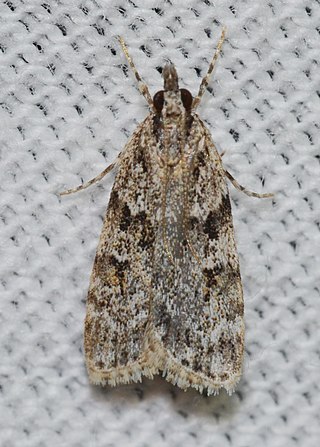
Scoparia is a grass moth genus of subfamily Scopariinae. Some authors have assigned the synonymous taxon Sineudonia to the snout moth family (Pyralidae), where all grass moths were once also included, but this seems to be in error.
Elophila atlantica is a moth in the family Crambidae. It was described by Eugene G. Munroe in 1972. It is found on North America, where it has been recorded from Nova Scotia, Florida, Maine, Maryland and South Carolina.

Elophila tinealis, the black duckweed moth, is a moth in the family Crambidae. It was described by Eugene G. Munroe in 1972. It is found in North America, where it has been recorded from Michigan, Ontario and New York, south to Florida and west to Texas. The habitat consists of swamps and wet woods.

Petrophila canadensis, the Canadian petrophila moth, is a moth in the family Crambidae. It was described by Eugene G. Munroe in 1972. It is found in North America, where it has been recorded from southern Canada and the north-eastern United States.
Petrophila hodgesi is a moth in the family Crambidae. It was described by Eugene G. Munroe in 1972. It is found in North America, where it has been recorded from Arkansas and Oklahoma.
Lipocosma septa, the exposed lipocosma moth, is a moth in the family Crambidae. It was described by Eugene G. Munroe in 1972. It is found in North America, where it has been recorded from Florida, Georgia, Maryland, North Carolina, Oklahoma, South Carolina, Texas and Virginia.
Plumegesta largalis is a moth in the family Crambidae. It was described by Eugene G. Munroe in 1972. It is found in North America, where it has been recorded from Florida.
Undulambia rarissima is a moth in the family Crambidae. It was described by Eugene G. Munroe in 1972. It is found in North America, where it has been recorded from Florida.
Cosipara chiricahuae is a moth in the family Crambidae. It was described by Eugene G. Munroe in 1972. It is found in North America, where it has been recorded from Arizona.
Cosipara modulalis is a moth in the family Crambidae. It was described by Eugene G. Munroe in 1972. It is found in North America, where it has been recorded from Arizona and Colorado.

Eudonia leucophthalma is a moth in the family Crambidae. It was described by Harrison Gray Dyar Jr. in 1929. It is found in North America, where it has been recorded from British Columbia and Alberta to Washington and California.
Eudonia franciscalis is a moth in the family Crambidae. It was described by Eugene G. Munroe in 1972. It is found in North America, where it has been recorded from California.
Eudonia franclemonti is a moth in the family Crambidae. It was described by Eugene G. Munroe in 1972. It is found in North America, where it has been recorded from Arizona.
Scoparia apachealis is a moth in the family Crambidae. It was described by Eugene G. Munroe in 1972. It is found in North America, where it has been recorded from Arizona, New Mexico and Utah.

Scoparia biplagialis, the double-striped scoparia moth, is a moth in the family Crambidae. It was described by Francis Walker in 1866. It is found in North America, where it has been recorded from Alabama, Alaska, Alberta, British Columbia, California, Colorado, Florida, Georgia, Illinois, Indiana, Kentucky, Maine, Manitoba, Maryland, Massachusetts, Michigan, Minnesota, Montana, New Brunswick, New Hampshire, New Jersey, New York, North Carolina, North Dakota, Nova Scotia, Ohio, Ontario, Oregon, Pennsylvania, Quebec, Tennessee, Virginia, Washington, West Virginia and Wisconsin.
Scoparia blanchardi is a moth in the family Crambidae. It was described by Eugene G. Munroe in 1972. It is found in North America, where it has been recorded from Texas.
Scoparia californialis is a moth in the family Crambidae. It was described by Eugene G. Munroe in 1972. It is found in North America, where it has been recorded from California.
Scoparia dominicki is a moth in the family Crambidae. It was described by Eugene G. Munroe in 1972. It is found in North America, where it has been recorded from Florida, North Carolina, Oklahoma, South Carolina and West Virginia.
Scoparia ruidosalis is a moth in the family Crambidae. It was described by Eugene G. Munroe in 1972. It is found in North America, where it has been recorded from New Mexico.
Psammobotys alpinalis is a moth in the family Crambidae. It was described by Eugene G. Munroe in 1972. It is found in North America, where it has been recorded from California.




